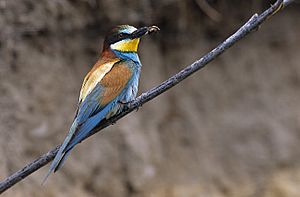Bee-eaters in Britain facts for kids
Bee-eaters are colorful birds, known for eating insects, especially bees. Two types of bee-eaters have visited Britain naturally. A third type has also been seen, but it was likely an escaped pet.
Contents
European Bee-eaters in Britain
The European bee-eater is the most common type seen in Britain. They usually arrive in spring, often flying further north than their usual homes. For a long time, seeing one was very rare! But since 1991, more have been visiting. They are sometimes seen in autumn too, but not as often. These birds have even tried to nest in Britain a few times.
When Do European Bee-eaters Visit Britain?
European bee-eaters are often seen in Britain during spring. This happens when they fly past their usual breeding areas. They are much rarer visitors in the autumn.
Have European Bee-eaters Nested in Britain?
Yes, European bee-eaters have tried to nest in Britain on several occasions. Here are some known attempts:
- In 1920, a pair tried to nest in a sand bank near Musselburgh, Scotland. Sadly, the female was captured and died.
- In 1955, three pairs nested in a quarry near Plumpton, East Sussex. Seven young birds successfully flew from two nests. Many people visited to see them.
- In 2002, a pair nested at Bishop Middleham Quarry, County Durham. Five chicks hatched, but only two survived. About 15,000 people came to watch these special birds.
- In 2005, a pair nested near Hampton Bishop, Herefordshire. About 2,000 people saw them. Unfortunately, foxes destroyed the nest.
- A pair tried to nest in Dorset in 2006, but this attempt did not succeed.
- In 2014, two pairs nested on the Isle of Wight. A special viewing area was set up for people to watch them.
- In 2015, two pairs nested in a sand quarry near Brampton, Carlisle, Cumbria. The RSPB protected their nests.
- In 2017, seven pairs nested at a quarry in East Leake, Nottinghamshire. Thousands of bird-watchers came to see them.
Blue-cheeked Bee-eaters in Britain
The blue-cheeked bee-eater is much rarer than the European bee-eater in Britain. Only eight sightings of this bird have ever been recorded. Most of these sightings happened in mid-summer.
Where Have Blue-cheeked Bee-eaters Been Seen?
- St Mary's, Isles of Scilly, in July 1921.
- St Agnes, Isles of Scilly, in June 1951.
- Peterborough, Cambridgeshire, in September 1982.
- The Otter valley, Budleigh Salterton, Devon, in June and July 1987.
- Kennack Sands and Cadgwith, The Lizard, Cornwall, in June 1989.
- Cowden, East Yorkshire, in July 1989 (also seen in Leverton Marsh, Lincolnshire).
- Church Hougham, Kent, in July 1989.
- Bressay, Shetland, and nearby areas, in June and July 1997.
Escaped Bee-eater Species
Sometimes, bee-eaters escape from captivity and are seen in the wild.
- One white-fronted bee-eater has been recorded in Britain, likely an escape.
- A northern carmine bee-eater was seen in Mundesley, Norfolk, in May 2002. It was probably an escaped pet, but it acted like a wild bird and caught many insects.


